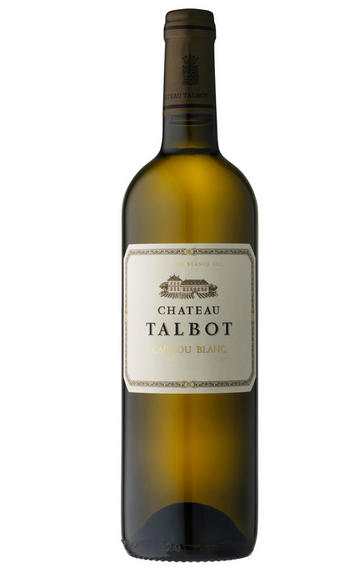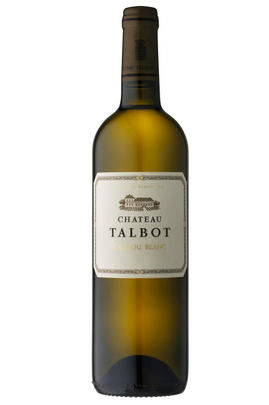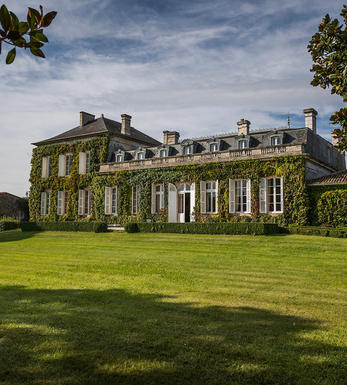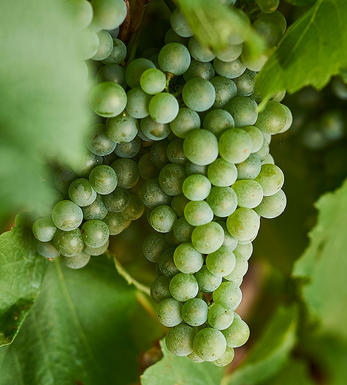
2021 Caillou Blanc, Château Talbot, Bordeaux

Critics reviews
The 2021 Caillou Blanc Talbot was picked September 14–16 and matured in 30% new oak. It has an attractive nose of orange pith and light apricot scents. The palate is well balanced with a pleasing fatness, not amazingly complex, yet the 27% Sémillon lends a lovely honeyed texture on the finish.
“It was a tricky vintage, but we made 44hL/ha as we are not organic,” Jean-Michel Laporte, Technical Director at Château Talbot, told me. “Unusually, we de-leafed at the end of August, which was helpful for [grape] maturity and easing botrytis pressure. It gave us another few days to wait before picking. We began harvest a week after our neighbours, so we had to be quick at the end and continued to pick over the weekend. We had been anxious about the rains but only had 8mm. I wanted to avoid astringency in the wine, but we did a bit more extraction than planned.”
Drink 2024 - 2034
Neal Martin, Vinous.com (May 2022)
Grass and green peas on the nose, a creamy touch to the fruits, a little sombre at this point, just in terms of less overt acidity, but this has a pleasing weight and gentle coursing of flavour with a viscous texture. Some honeyed almond, pineapple and red apple touches, too. I like the overall weight and texture; it is just a little less lively and focused than some.
Drink 2022 - 2030
Georgina Hindle, Decanter.com (April 2022)
About this WINE

Chateau Talbot
Château Talbot is one of the best-known Bordeaux wine estates to a UK audience, not surprisingly because it takes its name from John Talbot, Earl of Shrewsbury, who in 1453 suffered the ignominy of losing the battle, and with it his life, which allowed Bordeaux and its vineyards to slip back into French control after belonging to the British Crown for over 340 years.
In the last century it has been owned by the Cordier family, and the red wine of the estate has long enjoyed a reputation for solid dependability. It is one of the largest estates in the Médoc and its 102 hectare single vineyard is situated inland from the Gironde River and west of the hamlet of St-Julien-Beychevelle.
Georges Cordier, who owned the property in the mid-20th century, was a great lover of white wine, and, determined to produce his own, took the highly unusual step of planting 5 hectares of Sauvignon Blanc and Semillon in his vineyard, producing his first crop of white wine in 1945 (Le Caillou Blanc de Ch Talbot). The aim is to make wine in a Burgundian style, aged in oak barrels, with the 80% Sauvignon Blanc imparting vivacity and acidity, while the 20% Semillon imbues the wine with weight, backbone and ageing potential.
Red wine from Talbot is typically a blend of Cabernet Sauvignon (66%), Merlot (26%), Cabernet Franc (3%), and Petit Verdot (5%) - the vinification includes 18 months maturation in small oak barriques (50% new).
Talbot has a reputation for consistency and is one of the most carefully made and reliable of the St-Julien Cru Classé clarets. The best examples are richly aromatic with a bouquet of cedarwood and vanilla scented cassis fruits and with a palate packed with well-delineated, ripe, black fruits and finely integrated tannins. It is classified as a 4ème Cru Classé.

St Julien
St Julien is the smallest of the "Big Four" Médoc communes. Although, without any First Growths, St Julien is recognised to be the most consistent of the main communes, with several châteaux turning out impressive wines year after year.
St Julien itself is much more of a village than Pauillac and almost all of the notable properties lie to its south. Its most northerly château is Ch. Léoville Las Cases (whose vineyards actually adjoin those of Latour in Pauillac) but, further south, suitable vineyard land gives way to arable farming and livestock until the Margaux appellation is reached.
The soil is gravelly and finer than that of Pauillac, and without the iron content which gives Pauillac its stature. The homogeneous soils in the vineyards (which extend over a relatively small area of just over 700 hectares) give the commune a unified character.
The wines can be assessed as much by texture as flavour, and there is a sleek, wholesome character to the best. Elegance, harmony and perfect balance and weight, with hints of cassis and cedar, are what epitomise classic St Julien wines. At their very best they combine Margaux’s elegance and refinement with Pauillac’s power and substance.
Ch. Léoville Las Cases produces arguably the most sought-after St Julien, and in any reassessment of the 1855 Classification it would almost certainly warrant being elevated to First Growth status.
Recommended Châteaux: Ch. Léoville Las Cases, Ch.Léoville Barton, Ch Léoville Poyferré, Ch. Ducru-Beaucaillou, Ch Langoa Barton, Ch Gruaud Larose, Ch. Branaire-Ducru, Ch. Beychevelle

Sauvignon Blanc & Sémillon
The blend used for White Graves and Sauternes and rarely encountered outside France. In the great dry whites of Graves, Sauvignon Blanc tends to predominate in the blend, although properties such as Smith Haut Lafite use 100% Sauvignon Blanc while others such as Laville Haut Brion have as much as 60% Sémillon in their final blends. Sauvignon Blanc wines can lose their freshness and fruit after a couple of years in bottle - if blended with Sémillon, then the latter bolsters the wine when the initial fruit from the Sauvignon fades. Ultimately Sauvignon Blanc gives the wine its aroma and raciness while Sémillon gives it backbone and longevity.
In Sauternes, Sémillon is dominant, with Sauvignon Blanc playing a supporting role - it is generally harvested about 10 days before Sémillon and the botrytis concentrates its sweetness and dampens Sauvignon Blanc`s naturally pungent aroma. It contributes acidity, zip and freshness to Sauternes and is an important component of the blend.


Buying options
Add to wishlist
Description
Sauvignon Blanc 73%, and Sémillon 27%.
Always something of an individual wine, Talbot’s Caillou Blanc was one of the first whites to be produced in the Médoc. It has a powerful earthiness at its heart; it is harvested a bit later than its neighbours for that extra bit of richness. The cooler 2021 moderates this a little, but the drive is still there. A punchy but well-defined bouquet with notes of verbena and lime blossom is supported by a layered palate of pithy, waxy citrus fruit.
Drink 2023 - 2028
Our score: 17/20
Berry Bros. & Rudd
wine at a glance
Delivery and quality guarantee